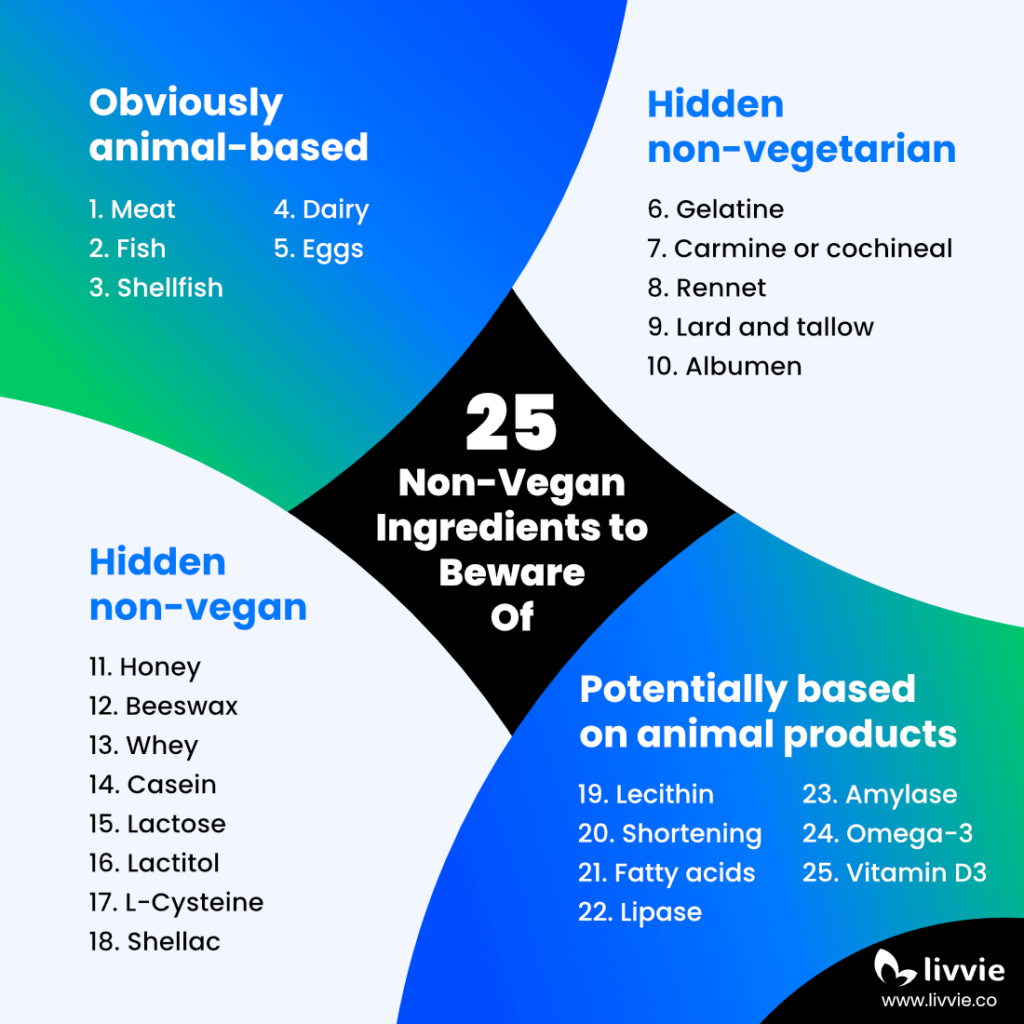Non-Vegan Ingredients to Avoid When Serving Food to Vegans
Written by Johanna van Langen
Published 15 December 2024
As the number of vegetarians and vegans continues to grow, it’s increasingly important for food service professionals to accommodate dietary preferences. Being able to identify non-vegan ingredients helps you align with suppliers, label dishes accurately, and handle questions, allergies and custom requests with confidence.
This guide lists non-vegan ingredients your team should be aware of to create a welcoming experience and enhance your brand reputation. Continue reading to learn which common, hidden, and potentially non-vegan ingredients to look out for when serving food to vegetarian and vegan guests.

Calculate the positive impact of serving more vegan food
Why Food Service Professionals Should Be Aware of Non-Vegan Ingredients
In the restaurant and catering business, being aware of non-vegan ingredients ensures your staff can confidently cater to vegan guests. Offering vegan-friendly menu options has several benefits, including attracting new customers and enhancing your brand image. Even when you don’t offer or advertise plant-based food, educating your waiters and kitchen staff on vegan ingredients enables them to confidently accommodate questions, allergies, and custom dietary requests.
The differences between vegetarian, plant-based, and vegan diets
To meet customer expectations in hospitality, it’s essential to understand the differences between vegetarian, plant-based, and vegan diets.
- Vegetarians avoid consuming animals and their flesh, including meat, fish, and shellfish.
- Plant-based diets exclude all ingredients of animal origin, so meat and fish, but also foods produced by animals such as dairy and eggs.
- Vegans avoid all ingredients involving animal exploitation during the production process. Veganism often extends to lifestyle choices beyond diet, such as avoiding clothes made of leather or wool or using cosmetics tested on animals.
- Flexitarians eat primarily plant-based but don’t entirely exclude animals from their diet.
- Pescatarians avoid eating meat from land animals, but still consume marine animals like fish and shellfish.
While these definitions appear straightforward, keep in mind that personal interpretations vary. Nuances are often related to the motivations behind consumer’s food choices, as well as what is practically feasible for the individual. Understanding different dietary preferences allows your staff to provide a tailored and respectful experience to restaurant guests.
Benefits of recognising non-vegan ingredients
Awareness about non-vegan ingredients across your organisation enables your staff to accommodate a growing group of conscious consumers and elevate their experience in several ways.
Informed purchasing
Knowing which ingredients to avoid allows you to confirm with suppliers that processed food products or ingredients are vegan-friendly. This diligence ensures transparency and reliability in your ingredient sourcing.
Cooking plant-based dishes
Chefs who are aware of hidden non-vegan ingredients and suitable alternatives are better equipped to create inventive plant-based dishes that appeal to vegan diners.
Accurate marketing and labelling
Knowledge of non-vegan ingredients helps to accurately label dishes, building a trustworthy reputation among vegan guests. Correct labelling also empowers your marketing team to promote vegetarian and vegan dishes effectively.
Prepared waiting staff
Training your waiting staff to understand non-vegan ingredients and dietary restrictions prepares them to answer questions professionally and confidently. Their knowledge helps drive customer satisfaction and demonstrates your commitment to transparency and inclusivity.
Beyond obvious non-vegan ingredients like meat, fish, dairy, and eggs, many processed foods contain hidden animal-derived components. Ensuring awareness about these ingredients across your organisation, improves your ability to cater to vegan guests and elevates your brand reputation. The following list provides a comprehensive overview of non-vegan ingredients commonly used in food, including ones that may surprise even experienced hospitality professionals.

Obvious Animal-Based Ingredients
For restaurant and catering professionals, most animal-based ingredients are easy to recognise. However, these ingredients can be present unexpectedly in processed or prepared foods, making vigilance necessary when accommodating vegan guests. Below are the most common animal-derived ingredients to watch for in your menu and sourcing.
1. Meat
Meat refers to the flesh and other edible body parts of land animals, including cattle, pigs, chickens, and sheep. While it’s often an obvious ingredient, meat extracts or powders can be hidden in broths, soups, and flavourings for processed foods.
2. Fish
Fish are aquatic animals have bones and fins, including cod, salmon, and anchovies. Beyond whole fish, fish-derived products like fish sauce, anchovy paste, or bonito flakes can be found in sauces, dressings, and seasonings.
3. Shellfish
Shellfish are aquatic animals with shells, such as shrimp, lobster, crab, and squid. Shellfish extracts are often used in sauces, bouillons, or as flavour enhancers, making them an unexpected ingredient in dishes like soups and stews.
4. Dairy
Dairy comes from mother’s milk from a cow, sheep, goat, or other mammal and includes derived products such as butter, cream, yogurt, and cheese. While it’s generally recognised as non-vegan, milk powder can be easily overlooked as it’s used in many processed foods like baked goods, snacks, and even seasoning mixes.
5. Eggs
Eggs are reproductive products laid by chickens and other birds such as quails. Beyond whole eggs, egg-derived ingredients are frequently used in confections, baked goods, and processed foods as stabilisers or foaming agents. Double-check labels for hidden egg components in packaged products.
Hidden Non-Vegetarian Ingredients
When catering to vegetarians and vegans, it’s important to recognise ingredients derived from animal body parts, even when their origins aren’t obvious. Many vegetarians unknowingly consume these ingredients, which can also catch food professionals off guard. Here’s an overview of common non-vegetarian ingredients that may go unnoticed on labels and during food preparation.
6. Gelatine
Gelatine is a gelling agent made by boiling the skin, bones, and connective tissues of animals, typically pigs or cows. It’s commonly found in gummy candies, marshmallows, and jelly desserts like panna cotta. When cooking for vegans, replace gelatine by plant-based alternatives like agar-agar or pectin.
7. Carmine or cochineal
Carmine, also known as cochineal, is a red dye made from crushed cochineal insects. This vibrant colouring is widely used in candies, icing, flavoured yogurts, beverages, and frozen desserts like popsicles. While it’s an effective natural dye, its insect-derived origin technically excludes it from vegetarian or vegan diets. Vegan-friendly alternatives include beet juice or synthetic colourings.
8. Rennet
Rennet is a complex of enzymes obtained from the stomach lining of calves when they’re slaughtered and is traditionally used to curdle milk during cheese production. Although most cheeses today are made with microbial or plant-based rennet, many European cheeses like Parmesan, Pecorino, and Gorgonzola often contain animal-based rennet. Always verify the source of rennet when labelling a cheese-based dish as vegetarian-friendly.
9. Lard and tallow
Lard (pork fat) and tallow (rendered beef or mutton fat) are frequently used in baking and cooking. They can appear in pie crusts, fried foods, tortillas, biscuits, and pastries. Their inclusion makes these dishes unsuitable for vegetarian guests. Plant-based shortening or vegetable oils are suitable alternatives for creating vegetarian-friendly versions.
10. Albumen
Albumen refers to egg whites, which are protein-rich and often used in powdered form as stabilisers or foaming agents in confections, baked goods, and processed foods. While albumen is a specific term for egg whites, note that similar sounding albumin refers to a class of proteins found in both animal and plant sources.

Hidden Non-Vegan Ingredients
Certain ingredients may not be immediately recognisable as non-vegan because their animal origins are less apparent. While some plant-based eaters might be less strict, vegans typically avoid any ingredient derived from animal exploitation. Understanding these hidden non-vegan ingredients helps ensure your dishes are accurately labelled, avoiding misunderstandings and building trust with vegan diners. Here’s a list of common hidden non-vegan ingredients and their typical uses.
11. Honey
Honey, a natural sweetener made by bees from flower nectar, is not vegan as it involves the exploitation of bees. It’s often found in baked goods, granola, salad dressings, and beverages. Plant-based alternatives for honey are maple syrup or agave nectar.
12. Beeswax
Beeswax is another bee-derived product commonly used as a coating or glazing agent in foods. It’s often found in candies, chewing gum, and fruit coatings to extend shelf life. Vegan substitutes include carnauba wax or candelilla wax.
13. Whey
Whey is a by-product of cheese production and is often used in baked goods, protein powders, and processed foods for its functional and nutritional properties. Verify that bread and other baked goods don’t contain whey before offering them as vegan options.
14. Casein
Casein, a milk-derived protein, is commonly used in non-dairy cheeses, creamers, margarine, and certain sweets. Its presence makes these items unsuitable for vegans. When offering vegan alternatives, don’t rely on “non-dairy” labels and ensure plant-based proteins like soy or pea are used instead.
15. Lactose
Lactose is a milk sugar frequently used as a sweetener in confectionery, baked goods, and some fermented beverages like beer. Check the food labels to ensure vegan-friendly sugars are used.
16. Lactitol
Lactitol, a sugar alcohol derived from lactose, is used as a low-calorie sweetener in sugar-free chocolates, sauces, and baked goods. If products contain sweeteners, make sure plant-based alternatives are used.
17. L-Cysteine
L-Cysteine, an amino acid derived from animal hair or feathers, is commonly used in bread-making to enhance dough elasticity. Ensuring plant-based dough conditioners are used is an easy way to ensure your bread dishes are accessible for vegans.
18. Shellac
Shellac, also called confectioner’s glaze, is made from lac bug secretions. It’s widely used to give a shiny finish to candies, sprinkles, and fruit coatings.

Ingredients Potentially Based on Animal Products
Some food ingredients can be derived from both animal and plant sources or produced synthetically, making it tricky to determine their origins. Accurate labelling of menu items as vegan may require verification of these ingredients with your suppliers if the source isn’t specified. Below is a list of commonly used ingredients that may be animal-derived, along with their typical uses.
19. Lecithin
Lecithin is an emulsifier commonly used in processed foods like chocolate, baked goods, and margarine. It’s usually derived from soy or sunflower (making it vegan), but it can also come from animal sources like egg yolk.
20. Shortening
Shortening refers to solid fats used in baking and cooking, particularly in pastries, pie crusts, and cookies. It can be made from animal fats such as lard or tallow or plant-based oils like palm or soybean.
21. Fatty acids
Fatty acids, including oleic acid, stearic acid, and palmitic acid, are often used as emulsifiers or stabilisers in processed foods like margarine, baked goods, and ice cream. Fatty acids can be derived from plant oils or animal fats.
22. Lipase
Lipase is an enzyme used to enhance flavours and textures, particularly in cheese and bread. While microbial and plant-based lipase options exist, it’s often sourced from animal tissues, such as the stomachs or tongues of calves or lambs.
23. Amylase
Amylase is an enzyme that breaks down starches, widely used in baking, brewing, and processed foods. Although most amylase is derived from microbial sources (making it vegan-friendly), it can also be extracted from animal glands.
24. Omega-3
Omega-3 fatty acids are often added to fortified foods and typically derived from fish oil. However, vegan alternatives sourced from algae are available. When incorporating omega-3-enriched products in dishes, confirm that they use algae-based omega-3 to meet vegan requirements.
25. Vitamin D3
Vitamin D3, commonly found in fortified foods like cereals and plant-based milks, is often derived from lanolin, a waxy substance extracted from sheep’s wool. When using fortified ingredients for vegan dishes, make sure vitamin D3 is derived from plant-based sources such as lichen.
Foods Produced Using Animal Products
In addition to animal-derived ingredients that end up in food, some production processes use animal products even though they don’t remain in the final product. Whereas people on a plant-based diet may not object to this, vegans seek to avoid animal exploitation altogether. Knowing the source of your ingredients helps your staff to be prepared for questions about production methods from vegan customers.
Refined sugar
Traditionally, white sugar was refined using bone char made from ground animal bones to decolourise sugar. While most manufacturers now use alternative methods, some sugar may still be processed this way. Vegan guests may inquire about it, so confirm with your supplier and opt for vegan-certified or unrefined sugars when possible.
Fermented drinks
Fermented beverages like beer and wine are often clarified using isinglass, a gelatine derived from fish bladders, or albumen (egg white), making them non-vegan. Since it’s not always clear whether animal-based products were used during production, ask your supplier or ensure you offer at least one vegan-friendly beer and wine option. Look for beverages labelled as vegan or certified by organisations like the Vegan Society.

Foods That May Involve Exploitation of Animals
For many vegans, avoiding animal ingredients isn’t the only consideration. Some extend their ethical stance to include any form of animal exploitation in the supply chain. Understanding these concerns can help you cater to ethically conscious diners, even though answering questions about supply chain practices can be challenging.
Examples of foods that may involve animal exploitation
- Truffles are typically harvested with the help of pigs or dogs trained to locate them underground. While the animals aren’t harmed in the process, some vegans avoid truffles due to the involvement of animals.
- Coconuts are sometimes harvested using monkeys trained to climb trees and pick the fruit, in some regions. This practice has raised concerns among ethical vegans about animal labour.
Certain aspects of your supply chain may be difficult to trace and even suppliers may not have details about animal involvement during, for example, pollination or transportation. Nevertheless, it’s worth understanding the considerations of vegans and being prepared for questions about the use of animals in your supply chain.
Awareness of Non-Vegan Ingredients Helps Confidently Catering To Vegans
Knowledge about non-vegan ingredients helps improve customer satisfaction and differentiate your restaurant or catering business, even when you don’t explicitly promote plant-based food. By educating your team on non-vegan ingredients, you empower them to source carefully, label dishes accurately, and confidently handle questions, allergies, and custom requests.
Taking the time to identify animal-derived ingredients and address concerns of vegan guests shows your commitment to transparency, quality, and inclusivity. With staff aware of non-vegan ingredients, you can provide a welcoming experience to a growing group of conscious consumers while enhancing your brand reputation.
Curious about the impact of using more vegan ingredients? Try the Livvie Business food impact calculator to measure your positive impact on the planet, animals, and health.

Share this article with fellow hospitality professionals to spread awareness of potentially hidden non-vegan ingredients.

